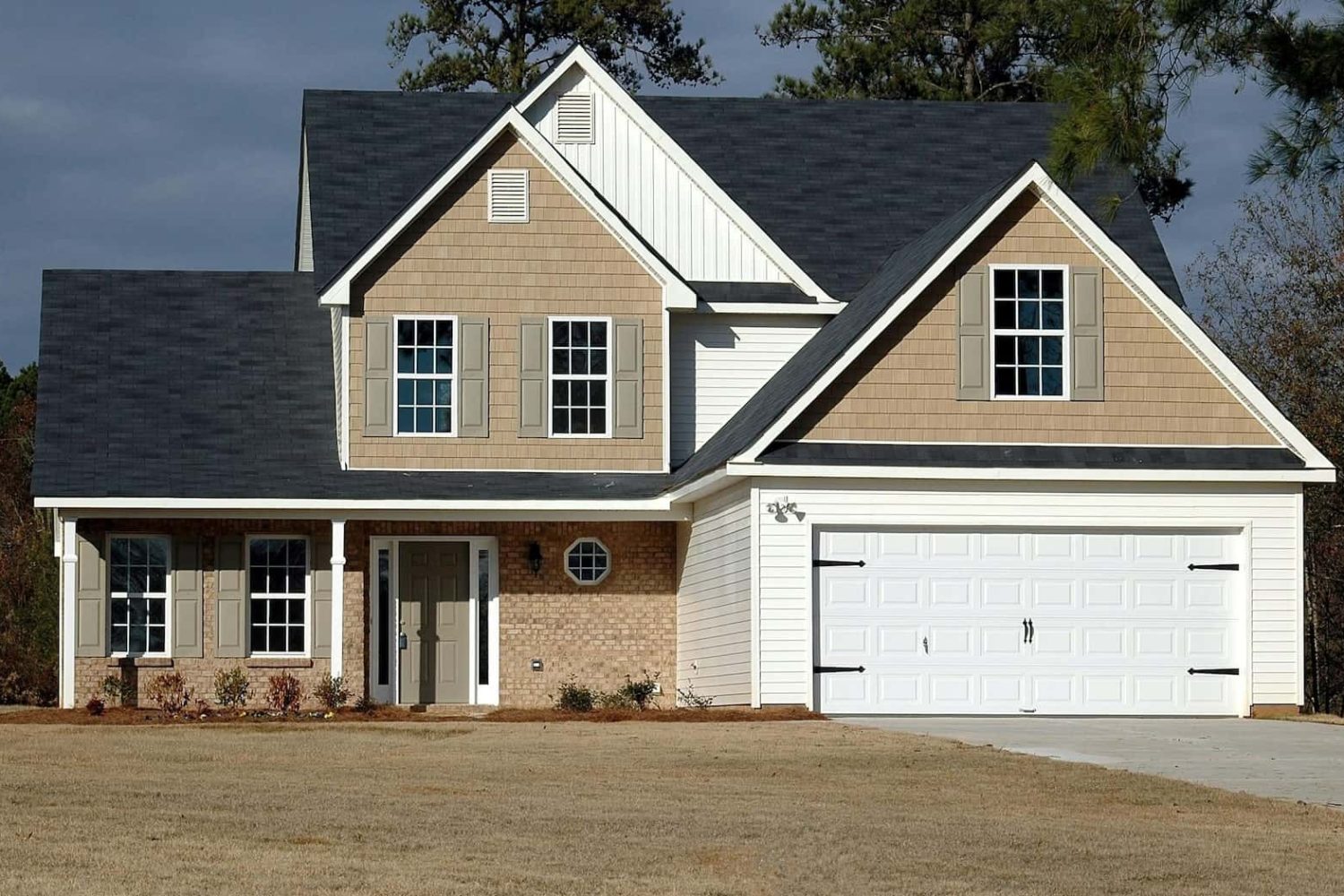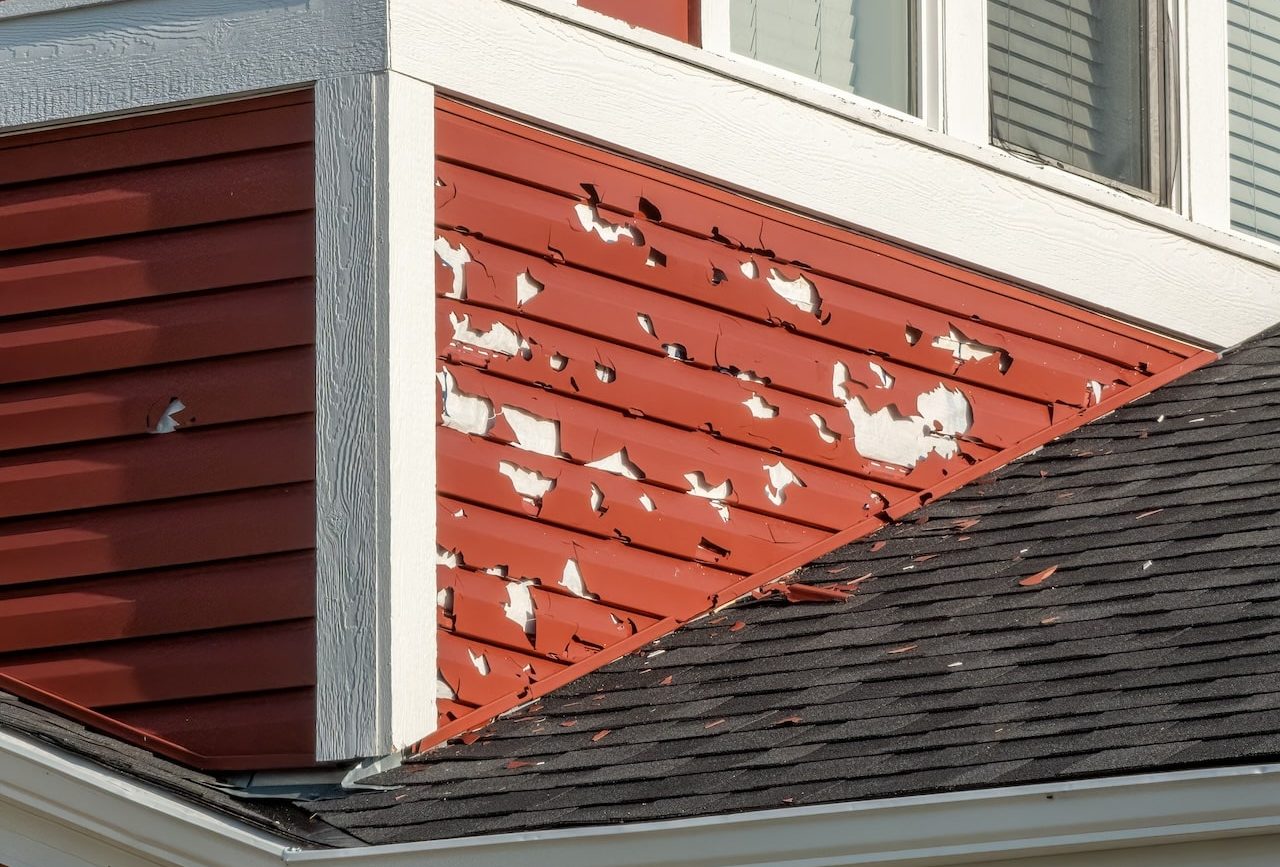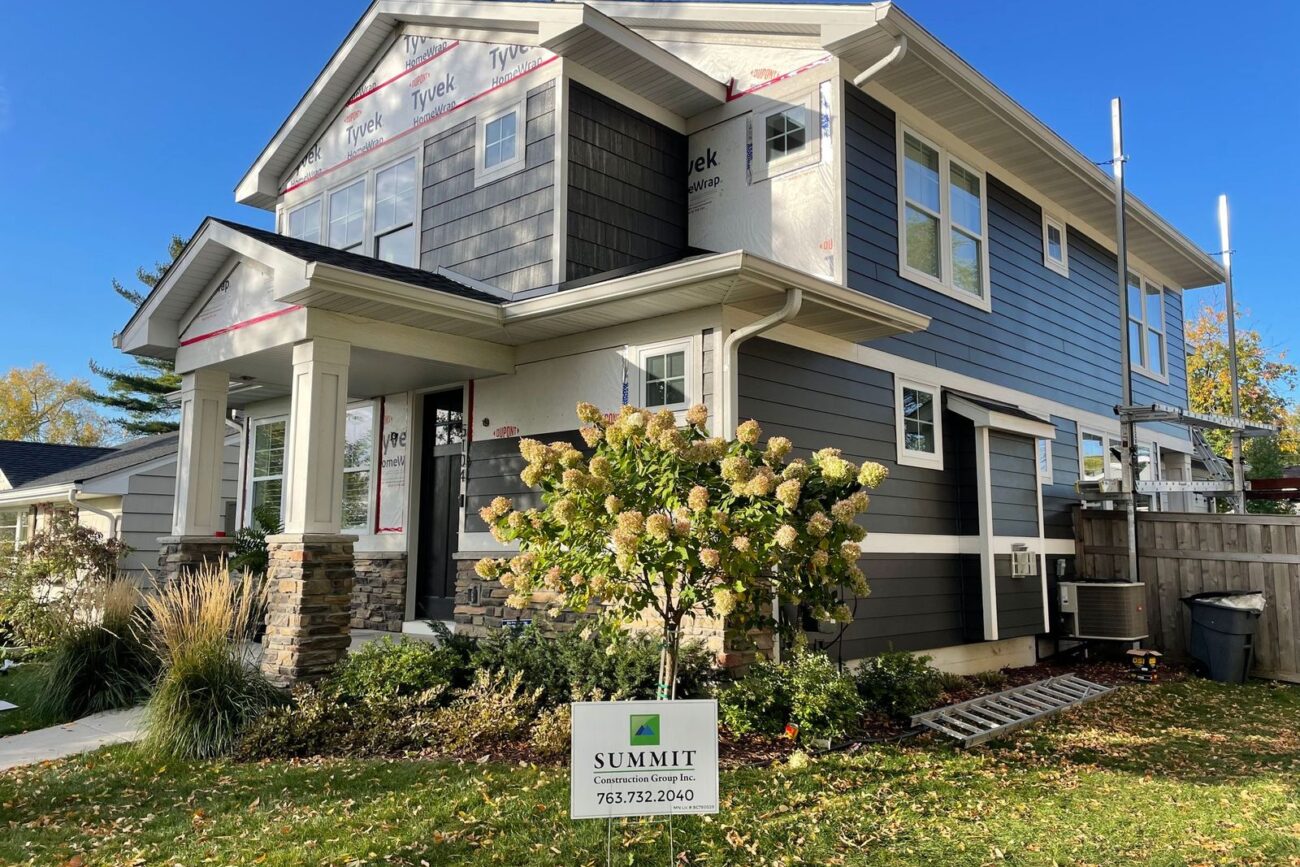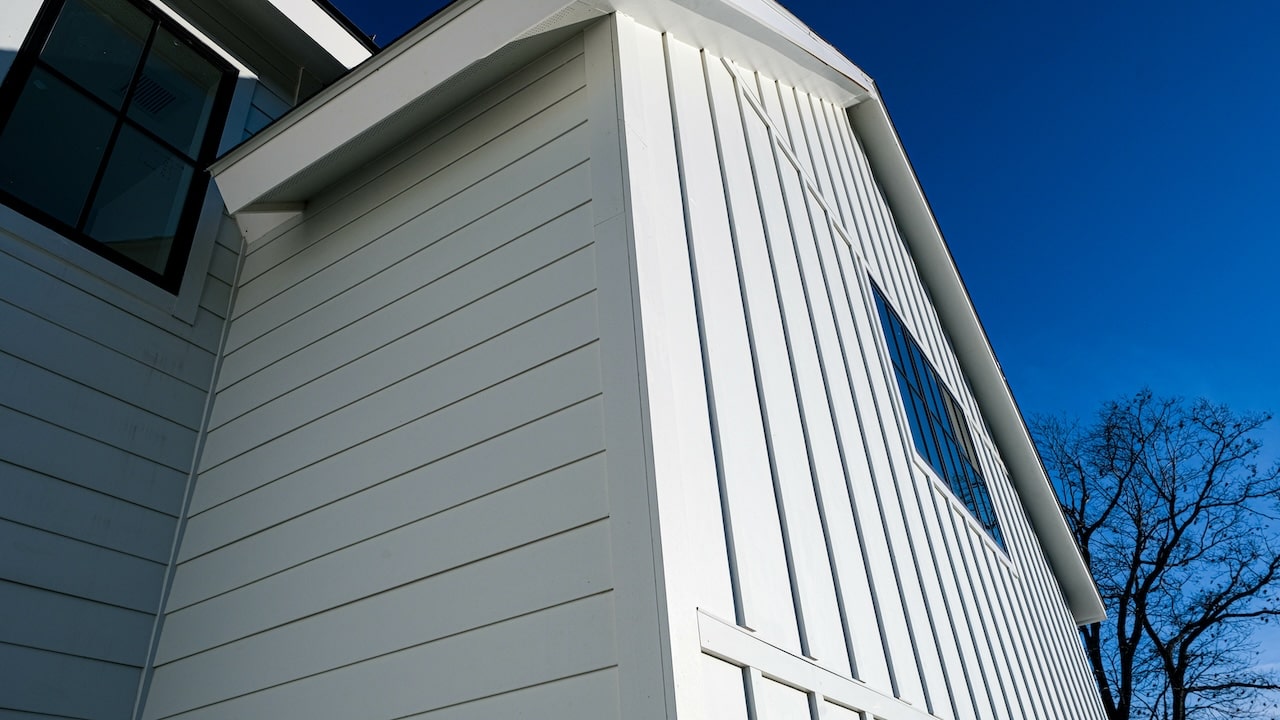Minnesota weather can be brutal. Freeze/thaw cycles, hail storms, and summer sun all take their toll on a home’s exterior. Cracks, warping, fading…you name it and it’s probably happened to your house. The good news is that not every problem is a full tear-off situation. Sometimes a simple siding repair can save you money and prolong your existing exterior. Other times replacement is the only long-term solution.
In this article, we’ll cover how to know if siding repair or siding replacement is right for your home, what each option costs in the Twin Cities, and other Minnesota climate-related factors to consider.
Quick repair vs. replace decision matrix at a glance
Knowing when to replace siding versus when a repair will do comes down to the scale of damage and the condition of underlying sheathing.
Repair if:
- Small, isolated cracks or holes are only on a few panels
- One elevation has cosmetic hail pitting but sheathing is sound
- Localized moisture staining without sheathing damage or softness
- Minor wood rot that can be cut out and patched
- Loose or warped sections caused by fastener failure and not systemic heat or installation errors
- Color match is possible and limited to low visibility areas
Replace if:
- Water intrusion is repeated, sheathing is soft, or mold is behind the cladding
- Warping or buckling is widespread across elevations
- Multiple materials are mixed from past repairs and color is severely sun-faded across elevations
- House wrap and flashing installation defects are discovered
- Frequent seasonal repairs are needed that outpace the one-time value of replacement
Minnesota-specific patterns of wear that matter
Life in Minnesota means siding challenges that other climates don’t share:
- Freeze-thaw cycles: Constant expansion and contraction puts stress on fasteners, can open seams, and cause small gaps that invite moisture.
- Wind-driven rain, ice dams: Water can find paths around windows, doors, and roof-to-wall connections. Ice dams and wind-driven rain are major contributors to moisture intrusion in exterior walls, which can spread unnoticed until siding is removed.
- Hail, UV exposure: South and west elevations often have visible denting, micro-cracks, and fading years earlier than the north side.
For these reasons, siding replacement may be needed sooner than expected, especially if there are any signs of moisture intrusion or systemic installation defects.
Inspection checklist
Checking the condition of house wrap and flashing is critical, since installation gaps are a leading cause of moisture problems. Before deciding on siding repair versus replacement, a good inspection is essential:
- Exterior walk-around: Is there buckling, loose courses, corner/trim gaps, or discoloration?
- Probe tests: Can any softness be detected in wood siding, soffit, or fascia?
- Moisture checks: Is there sheathing behind suspect panels?
- Pest damage: Are there any signs of pest damage or water splashback near grade level?
- Flashing review: Kick-out flashing at roof-to-wall transition, and is it present around windows/doors?
- House wrap continuity: If panels are removed, look for staining, missing wrap, and tears.
- Ventilation: Is there good airflow from attic/soffit to prevent condensation?
- Documentation: Storm-related photos by elevation for insurance claims may be needed.
Don’t forget soffit and fascia repair in your inspection, since these components often reveal hidden moisture or ventilation issues.
Guidance for each siding material
Vinyl siding repair vs. replacement
- Repair-friendly: Cracked or broken off panels, isolated warps, and hail dings.
- Replace when: Buckling from heat distortion, color fade across an entire elevation, or brittle aging that makes repair difficult.
Fiber cement siding replacement (James Hardie)
- Repair-friendly: Individual board replacement if impact damage is localized.
- Replace when: Moisture and flashing issues are widespread, or paint failure suggests substrate problems. James Hardie siding often has manufacturer-specific installation requirements to maintain warranty.
Engineered wood (LP SmartSide) siding repair
- Repair-friendly: Confined swelling and edge damage that hasn’t spread. LP SmartSide repair is usually possible for small areas of swelling or edge damage that haven’t spread into the substrate.
- Replace when: Repeated swelling, decay, or substrate rot. Systemic installation defects often call for full replacement.
Wood siding rot repair
- Repair-friendly: Small sections can be cut out, dutchman patched, primed, and repainted.
- Replace when: Rot is widespread, insect damage present, or maintenance becomes a yearly chore.
Steel and aluminum siding repair
- Repair-friendly: Dent removal or isolated panel replacement.
- Replace when: Coating failure, widespread oil-canning, or there’s fading across an entire elevation.
Cost comparison: Repair vs. full replacement
Repair costs range in Minneapolis
Homeowners often ask about siding repair cost, which in the Twin Cities is driven by factors like material availability, elevation height, and labor access.
Many siding repair projects cost $460-$1,795, with an average of about $1,119. National per-square-foot costs are $2-$50, depending on material and complexity.
What drives cost? Material availability, elevation height, color matching, panel removal and reinstall time, trim blending, and repainting or staining are all factors to consider.
Replacement cost in Minnesota
Vinyl siding replacement in Minneapolis averages between $10,257-$21,955, with a midpoint near $15,201. Costs increase for larger footprints, multi-story homes, tear-off and new house wrap and flashings, soffit and fascia repair, and disposal. James Hardie fiber cement siding replacement typically costs more than vinyl but delivers greater durability and curb appeal.
ROI and replacement context
According to Cost vs. Value reports, siding replacement is almost always one of the highest-return home exterior projects. It also offers better energy efficiency siding performance and resets warranties.
Insurance and storm-related replacement
After severe weather, hail damage siding claims are among the most common reasons Minnesota homeowners call their insurance company. For homeowners who do file a siding insurance claim in Minnesota, all elevations with photos and receipts should be documented. Storm damage siding in Minnesota cases often also include wind-driven rain, which can require temporary tarping until a contractor can assess the full scope.
- When to file insurance: If a storm has damaged multiple elevations or sheathing, homeowners can file a siding insurance claim in Minnesota.
- Documentation: Take pictures of every elevation, date-stamp visible damage, and keep receipts for tarps or temporary protection.
- Consumer protections: The Minnesota Department of Commerce offers homeowners guidance for storm-damage and contractor disputes.
- Temporary solutions: Use tarps or plywood to prevent further water intrusion until a siding contractor in your area can schedule a visit.
Aesthetics and color matching
The ability to match existing siding color depends on sun exposure and manufacturer availability, and sometimes partial replacement is the only way to blend seamlessly. Sun fading often causes new panels to stand out versus old siding. Repaired patches can be especially obvious on south and west elevations.
Solutions include:
- Partial siding replacement of a whole wall or elevation
- Trim breaks and transition boards to disguise repairs
- Repainting or staining (on wood and fiber cement) to blend
Warranties and long-term maintenance
The siding warranty Minnesota homeowners receive will vary by material and contractor, but full-system replacements often reset both manufacturer and workmanship coverage.
- Warranties: Improper siding repair might void manufacturer warranties. A full-system siding replacement often resets both manufacturer and workmanship.
- Maintenance roadmap:
- Vinyl: Annual washing, inspect caulk.
- Fiber cement: Repaint every 10–15 years; caulk checks every 2–3 years.
- LP SmartSide: Maintain paint/sealant regularly.
- Wood: Repaint/stain every 5–7 years; watch for rot.
- Steel/aluminum: Wash annually; touch up coatings as needed.
Timeline, disruption, and seasonality
- Repairs: Typically 1/2 day to two days.
- Replacements: Multi-day to week-long projects depending on size and material.
- Seasonality: Minnesota contractors schedule around rain, snow and freeze-thaw conditions. Special-order colors and profiles may take longer.
- Job site prep: Expect a dumpster on the property, landscape protection, and daily cleanup.
Partial replacement vs. full tear-off
- Partial siding replacement: Ideal for an isolated hail path, garage walls, or a single elevation.
- Risks: Profile or color mismatch, seams between new and old material, hidden damage in other areas.
- Full tear-off: Resets house wrap and flashings, delivers a uniform look and realigns warranties.
How Summit Construction Group helps you decide
Choosing a siding contractor in Minnetonka that residents trust means working with a team that knows the local climate and code requirements inside and out.
Summit Construction Group provides:
- Full-system inspections: WRB, flashing, soffit, and fascia review.
- Material neutral: Vinyl, James Hardie, LP SmartSide, steel, or wood are all options. Material recommendations are based on the client’s budget and project goals.
- Transparent estimates: Separating necessary repairs, smart upgrades, and optional aesthetic improvements are always based on client budgets.
- Proven track record: Local portfolio in Minnetonka and surrounding communities, plus clean, professional project management.
Contact Summit Construction Group today for a no-pressure inspection.
FAQs
How do I know if moisture is getting behind my siding?
Look for staining, soft spots, or mold near interior walls; a professional probe test can confirm.
Can I only replace the damaged section?
Yes, for vinyl or steel/aluminum. Fiber cement and wood are more challenging and may require larger sections to replace.
Will a repair be obvious from the street?
Sometimes, especially on faded elevations. Partial replacements or repainting may blend better.
How long does a repair vs. replacement project take?
- Repairs: 1-2 days.
- Replacements: Several days to a week, depending on size.
Do I need permits in my city for siding work?
In most Minnesota cities, yes, especially for full replacements. Your contractor should know and handle this.
What’s the siding lifespan in Minnesota’s climate?
The siding lifespan in Minnesota’s climate allows is shorter than in milder regions because of the region’s freeze-thaw cycles, hail, and UV exposure all accelerate wear. Typical lifespans are:
- Vinyl: 20-40 years.
- Fiber cement (James Hardie): 30-50 years.
- Engineered wood (LP): 20-30 years.
- Wood: Highly variable, often 15-25 years with high upkeep.
Can insurance cover hail-related siding replacement?
Yes, if damage is widespread and documented.
How soon can work start after a storm?
Contractors book quickly, so schedule an inspection early, even if no work is done right away.
What maintenance should I expect after repair or replacement?
Annual wash, caulk checks, repainting by material.
Will new siding improve energy efficiency or noise?
Yes, especially with added insulation, house wrap, and flashing improvements.
Can Summit Construction Group match existing profiles/colors?
Often, but exact matches can be challenging on older, sun-faded siding.
What warranties should I expect?
Manufacturer coverage plus workmanship warranty from your contractor. A full replacement resets both.
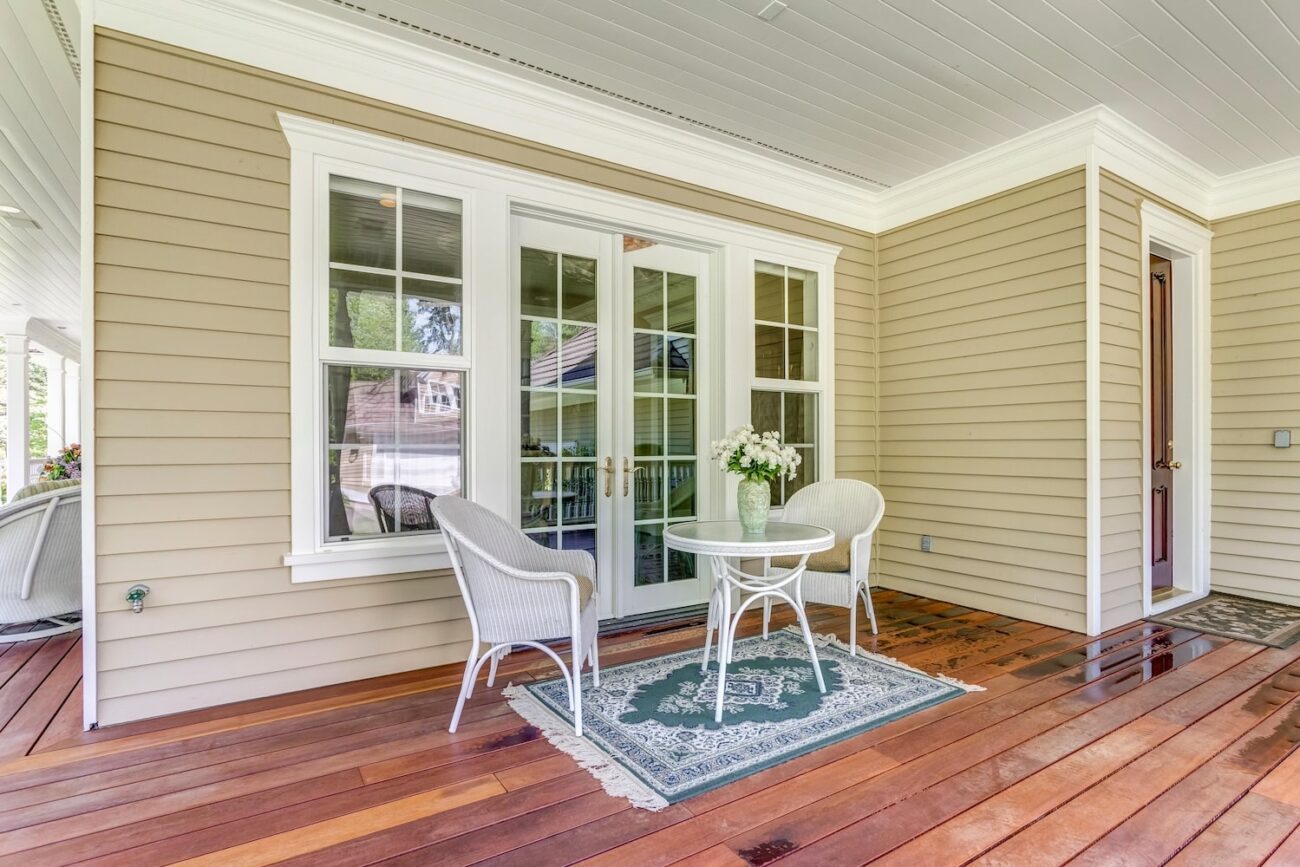
Know which decision is best for your home?
Minnesota weather can test even the sturdiest of exteriors. If damage is localized and color-matching is easy, siding repair is often enough to protect your home and your budget. But if water intrusion, fading, or larger-scale flaws are present, siding replacement restores long-term durability, warranty coverage, and curb appeal.
Ready to take the next step? Start with an honest inspection. Request your free estimate today or for more homeowner tips, visit our Siding FAQs.

